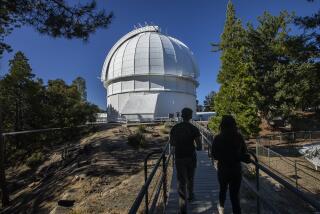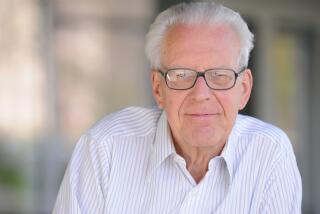A Scientific Star After All
- Share via
Astronomer Edwin P. Hubble was relentlessly self-promoting, even hiring a publicity agent in an unsuccessful attempt to persuade the Swedish Academy to award him the Nobel Prize. It’s no surprise that his critics saw him as more showman than scientist--closer in spirit to Hollywood stars than to heavenly ones. Last week, however, a team of astronomers based at Pasadena’s Carnegie Observatories announced the result of a landmark, eight-year study that nails down the unassailable significance of the key discoveries that Hubble made from observations through his 100-inch Hooker Telescope atop Mt. Wilson.
Painstakingly analyzing images taken over 400 hours with the Hubble Space Telescope, named after the Southern California astronomical pioneer, the Carnegie team used Hubble’s technique of measuring stars’ motion, based on their shifting luminosity and colors, to confirm his key insight: that galaxies are rushing away from one another and that the farther apart they are, the faster they are separating.
Moviemaking and astronomy might be closer in spirit than Hubble’s critics realize. Both produce moments of epiphany after thousands of hours of labor. Like Hollywood directors, Hubble moved to Southern California for its clear skies and open-minded culture. He enjoyed the same freedom to take on conventional wisdom as that which attracted his friends Aldous Huxley and Charlie Chaplin to the region. Like them, Hubble challenged the status quo, most famously when he asserted that the Milky Way galaxy was merely one of millions of star systems in the cosmos, not the entire cosmos, as the astronomers of his day believed.
Hubble has often been described as clever but hobbled by vanity. History now suggests that Hubble’s hubris was a useful tool, enabling him to hold and express unconventional ideas. For instance, he insisted that he had accurately gauged the speed at which matter was expanding outward from the Big Bang, even though his calculations put the universe at least 2 billion years younger than one of the specks it contained, the planet Earth. He never flinched when geologists of his day pointed confidently to studies showing the Earth to be so much older than Hubble’s universe. Now, however, a treatise published in this week’s edition of the journal Science essentially vindicates Hubble’s approach.
The paper by UC Berkeley physicist Saul Perlmutter and colleagues at Princeton shows that Hubble correctly calculated the rapid clip at which the universe is expanding. The paradox, Perlmutter explains, arose not from miscalculations on Hubble’s part but from the limitations of knowledge in his day. Hubble had assumed that the universe had always traveled at today’s fast clip. Perlmutter’s paper outlines an emerging scientific consensus that the universe once traveled far more slowly and thus its expansion occurred over a far longer time.
Hubble’s discoveries underscore that science does not exist in a philosophical vacuum. It is a complex and very human enterprise, sometimes aided by a bit of showmanship.






